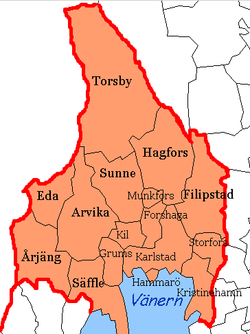Värmland rebellion
 From Wikipedia - Reading time: 3 min
From Wikipedia - Reading time: 3 min
| Värmland Rebellion | |||||||
|---|---|---|---|---|---|---|---|
 Map of Värmland county | |||||||
| |||||||
| Belligerents | |||||||
|
|
| ||||||
| Commanders and leaders | |||||||
|
|
| ||||||
| Strength | |||||||
| At least 100–120 | At least 700 | ||||||
| Casualties and losses | |||||||
| Unknown | At least 140 | ||||||
The Värmland Rebellion was a peasant uprising in the Swedish province of Värmland during the years of 1437–1438. While being successful in the beginning, the rebels were eventually defeated by the troops of Arvid Svan.[1]
Background
[edit]Erik Puke was a member of the Swedish National Council and had been very close to Engelbrekt Engelbrektsson. In December 1436 and January 1437, he led an uprising against the national leadership and its most powerful man, Karl Knutsson. The rebellion, the Puke feud, gained strong support among the common people in Mälardalen.[2]
Rebellion
[edit]In the autumn of 1437, the rebellion in Värmland broke out, the insurgents are led by the former retainer of Karl Knutsson, Torsten Ingelsson, and Jösse Hansson.[3] The first peasants to rebel were the ones in Älvdalen and Fryksdalen.[4] The Värmlanders killed the bailiff and took over large areas of the province, whereupon the rebellion spread to Närke.[4][5][6] The rebels eventually believed themselves to be powerful enough, and marched towards Örebro and Västerås. which are besieged.[5][3] Both castles was later able to be captured by the Värmlanders.[3]
The Swedish Seneschal of the Realm, Kristiern Nilsson (Vasa), who had the formal responsibility of dealing with the rebel threat, recommended diplomatic talks to confront the rebellion, but Karl Knutsson refused. Due to him having primary military responsibility in the kingdom, appointed Arvid Svan and a force of 100[3]-120[4] courtiers to subdue the rebellion.[5][3] Arvid Svan was successful in his task, he pursued the rebels back to Värmland, where many chose to pay taxes and capitulate.[5][3] In a battle between the troops of Arvid Svan and 700 rebels, and out of the 700, 140 lose their lives.[3]
However, not all of the rebels choose to give up, the ones in the Jösse district put themselves in a defensive stance, and were forced to be put down with force.[5][4]
Aftermath
[edit]After the rebellion was subdued, Arvid Svan continued to ravage Fryksdalen and Älvdalen,[4][5] and Torsten Ingelsson, along with Jösse Hansson were burned at the stake in February 1438, which formally ended the rebellion[5][3][4]
References
[edit]- ^ Kihlstadius, Roland (September 2011). "Strand-släkten" (PDF). Värmlands anor (in Swedish). p. 8. ISSN 1400-1047.
- ^ Harrison, Dick (2012-10-27). "Pukefejdens blodiga slut". blog.svd.se (in Swedish). Retrieved 2024-03-09.
- ^ a b c d e f g h Sundberg, Ulf (1999). Medeltidens svenska krig (in Swedish) (1st ed.). Stockholm: Hjalmarson & Högberg. p. 262. ISBN 9189080262.
- ^ a b c d e f Adolfsson, Mats (2010-12-21). När borgarna brann (in Swedish). Natur & Kultur. ISBN 978-91-27-12808-8.
- ^ a b c d e f g Harrison, Dick (2014-10-29). "Bondeuppror i Värmland". blog.svd.se (in Swedish). Retrieved 2024-03-10.
- ^ Katajala, Kimmo, ed. (2004). Northern revolts : medieval and early modern peasant unrest in the Nordic countries. Helsinki: Finnish Literature Society. ISBN 978-951-746-643-1 – via Internet Archive.
 KSF
KSF